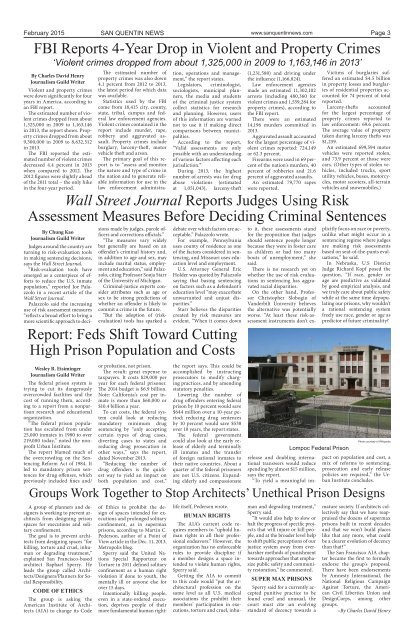san-quentin-news-february-2015-revision-i
san-quentin-news-february-2015-revision-i
san-quentin-news-february-2015-revision-i
- No tags were found...
You also want an ePaper? Increase the reach of your titles
YUMPU automatically turns print PDFs into web optimized ePapers that Google loves.
February <strong>2015</strong>By Charles David HenryJournalism Guild WriterViolent and property crimeswere down significantly for fouryears in America, according toan FBI report.The estimated number of violentcrimes dropped from about1,325,000 in 2009 to 1,163,146in 2013, the report shows. Propertycrimes dropped from about9,300,000 in 2009 to 8,632,512in 2013.The FBI reported the estimatednumber of violent crimesdecreased 4.4 percent in 2013when compared to 2012. The2012 figures were slightly aheadof the 2011 total – the only hikein the four-year period.A group of planners and designersis working to prevent architectsfrom designing prisonspaces for executions and solitaryconfinement.The goal is to prevent architectsfrom designing spaces “forkilling, torture and cruel, inhumanor degrading treatment,”explained San Francisco-basedarchitect Raphael Sperry. Heleads the group called Architects/Designers/Plannersfor SocialResponsibility.CODE OF ETHICSThe group is asking theAmerican Institute of Architects(AIA) to change its CodeSAN QUENTIN NEWSof Ethics to prohibit the designof spaces intended for execution<strong>san</strong>d prolonged solitaryconfinement, as in supermaxprisons, according to Martin C.Pederson, author of a Point ofView article in the Dec. 11, 2013,Metropolis blog.Sperry said the United NationsSpecial Rapporteur onTorture in 2011 defined solitaryconfinement as a human rightviolation if done to youth, thementally ill or anyone else forover 15 days.Intentionally killing people,even in a state-ordered execution,deprives people of theirmore fundamental human right:The estimated number ofproperty crimes was also down4.1 percent from 2012 to 2013,the latest period for which datawas available.Statistics used by the FBIcome from 18,415 city, county,state, tribal, campus and federallaw enforcement agencies.Violent crimes contained in thereport include murder, rape,robbery and aggravated assault.Property crimes includeburglary, larceny-theft, motorvehicle theft and arson.The primary goal of this reportis to “assess and monitorthe nature and type of crime inthe nation and to generate reliableinformation for use in thelaw enforcement administration,operations and management,”the report states.Legislators, criminologist,sociologists, municipal planners,the media and studentsof the criminal justice systemcollect statistics for researchand planning. However, usersof this information are warnednot to use it if making directcomparisons between municipalities.According to the report,“Valid assessments are onlypossible with an understandingof various factors affecting eachjurisdiction.”During 2013, the highestnumber of arrests was for drugabuse violations (estimatedat 1,051,043), larceny-theftwww.<strong>san</strong><strong>quentin</strong><strong>news</strong>.com Page 3FBI Reports 4-Year Drop in Violent and Property Crimes‘Violent crimes dropped from about 1,325,000 in 2009 to 1,163,146 in 2013’By Chung KaoJournalism Guild WriterJudges around the country areturning to risk-evaluation toolsin making sentencing decisions,says the Wall Street Journal.“Risk-evaluation tools haveemerged as a centerpiece of effortsto reduce the U.S. inmatepopulation,” reported Joe Palazzoloin a recent article of theWall Street Journal.Palazzolo said the increasinguse of risk assessment measures“reflects a broad effort to bring amore scientific approach to decisionsmade by judges, parole officer<strong>san</strong>d corrections officials.”“The measures vary widelybut generally are based on anoffender’s criminal history and,in addition to age and sex, mayinclude marital status, employmentand education,” said Palazzolo,citing Professor Sonja Starrof the University of Michigan.Criminal-justice experts considerattributes such as age orsex to be strong predictions ofwhether an offender is likely tocommit a crime in the future.“But the adoption of (riskevaluation)tools has sparked adebate over which factors are acceptable,”Palazzolo wrote.For example, Pennsylvaniauses county of residence as oneof the factors considered in sentencing,and Missouri uses educationlevel and employment.U.S. Attorney General EricHolder was quoted by Palazzolosaying that basing sentencingon factors such as a defendant’seducation level “may exacerbateunwarranted and unjust disparities.”Starr believes the disparitiescreated by risk measures areevident. “When it comes down(1,231,580) and driving underthe influence (1,166,824).Law enforcement agenciesmade an estimated 11,302,102arrests (including 480,360 forviolent crimes and 1,559,284 forproperty crimes), according tothe FBI report.There were an estimated14,196 murders committed in2013.Aggravated assault accountedfor the largest percentage of violentcrimes reported: 724,149or 62.3 percent.Firearms were used in 69 percentof the nation’s murders, 40percent of robberies and 21.6percent of aggravated assaults.An estimated 79,770 rapeswere reported.Groups Work Together to Stop Architects’ Unethical Prison Designslife itself, Pedersen wrote.HUMAN RIGHTSThe AIA’s current code requiresmembers to “uphold humanrights in all their professionalendeavors.” However, theorganization has no enforceablerules to provide discipline ifa member designs a space intendedto violate human rights,Sperry said.Getting the AIA to committo this code would “put the architecturalprofession on thesame level as all U.S. medicalassociations the prohibit theirmembers’ participation in executions,torture and cruel, inhumanand degrading treatment,”Sperry said.“It would also help to slow orhalt the progress of specific projectsthat will injure or kill people,and at the broader level helpto shift public perceptions of ourjustice system away from everharshermethods of punishmenttowards approaches that emphasizepublic safety and communityrestoration,” he commented.SUPER MAX PRISONSSperry said for a currently acceptedpunitive practice to befound cruel and unusual, thecourt must cite :an evolvingstandard of decency towards aVictims of burglaries sufferedan estimated $4.5 billionin property losses and burglariesof residential properties accountedfor 74 percent of totalreported.Larceny-thefts accountedfor the largest percentage ofproperty crimes reported tolaw enforcement: 69.6 percent.The average value of propertytaken during larceny thefts was$1,259.An estimated 699,594 motorvehicles were reported stolen,and 73.9 percent or those werecars. (Other types of stolen vehicles,included trucks, sportutility vehicles, buses, motorcycles,motor scooters, all-terrainvehicles and snowmobiles.)Wall Street Journal Reports Judges Using RiskAssessment Measures Before Deciding Criminal SentencesReport: Feds Shift Toward CuttingHigh Prison Population and CostsWesley R. EisimingerJournalism Guild WriterThe federal prison system istrying to cut its dangerouslyovercrowded facilities and thecost of running them, accordingto a report from a nonparti<strong>san</strong>research and educationalorganization.“The federal prison populationhas escalated from under25,000 inmates in 1980 to over219,000 today,” noted the nonprofitUrban Institute.The report blamed much ofthe overcrowding on the SentencingReform Act of 1984. Itled to mandatory prison sentencesfor drug offenses, whichpreviously included fines and/or probation, not prison.The result: great expense totaxpayers. It costs $29,000 peryear for each federal prisoner.The 2014 budget is $6.9 billion.Note: California’s cost per inmateis more than $60,000 or$10.4 billion a year.To cut costs, the federal systemcould look at reducingmandatory minimum drugsentencing by “only acceptingcertain types of drug cases,diverting cases to states andreducing drug prosecution inother ways,” says the report,dated November 2013.“Reducing the number ofdrug offenders is the quickestway to yield an impact onboth population and cost,”the report says. This could beaccomplished by instructingprosecutors to modify chargingpractices, and by amendingstatutory penalties.Lowering the number ofdrug offenders entering federalprison by 10 percent would save$644 million over a 10-year period;reducing drug sentencesby 10 percent would save $538over 10 years, the report states.The federal governmentcould also look at the early releaseof elderly and terminallyill inmates and the transferof foreign national inmates totheir native countries. About aquarter of the federal prisonersare not U.S. citizens. Expandingelderly and compassionateLompoc Federal Prisonto it, these assessments standfor the proposition that judgesshould sentence people longerbecause they were in foster careas children or had too manybouts of unemployment,” shesaid.There is no research yet onwhether the use of risk evaluationsin sentencing has aggravatedracial disparities.On the other hand, ProfessorChristopher Slobogin ofVanderbilt University believesthe alternative was potentiallyworse. “At least these risk-assessmentinstruments don’t explicitlyfocus on race or poverty,unlike what might occur in asentencing regime where judgesare making risk assessmentsbased on seat-of-the-pants evaluations,”he said.In Nebraska, U.S DistrictJudge Richard Kopf posed thequestion, “If race, gender orage are predictive as validatedby good empirical analysis, andwe truly care about public safetywhile at the same time depopulatingour prisons, why wouldn’ta rational sentencing systemfreely use race, gender or age aspredictor of future criminality?Photo courtesy of Wikipediarelease and doubling internationaltranswers would reducespending by almost $15 million,says the report.“To yield a meaningful impacton population and cost, amix of reforms to sentencing,prosecution and early releasepolicies are required,” the UrbanInstitute concludes.mature society. If architects collectivelysay that we have reappraisedthe dozens of supermaxprisons built in recent decade<strong>san</strong>d that we won’t build placeslike that any more, what couldbe a clearer evolution of decencythan that?”The San Francisco AIA chapterbecame the first to formallyendorse the group’s proposal.There have been endorsementsby Amnesty International, theNational Religious CampaignAgainst Torture, the AmericanCivil Liberties Union andDesignCorps, among othergroups.–By Charles David Henry





